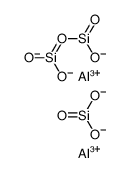铝硅酸盐

铝硅酸盐结构式

|
常用名 | 铝硅酸盐 | 英文名 | Aluminatesilicate |
|---|---|---|---|---|
| CAS号 | 1327-36-2 | 分子量 | 288.26200 | |
| 密度 | N/A | 沸点 | N/A | |
| 分子式 | Al2H6O9Si3 | 熔点 | N/A | |
| MSDS | 美版 | 闪点 | N/A |
|
Optical detection/collection of toxic Cd(II) ions using cubic Ia3d aluminosilica mesocage sensors.
Talanta 98 , 69-78, (2012) Optical sensors for selective removal and detection of extremely toxic ions such as cadmium (Cd(II)) in aquatic samples were successfully fabricated via simple strategy. Aluminosilica-based network platforms are used as selective mesopore shape and size carri... |
|
|
Metal stabilization mechanism of incorporating lead-bearing sludge in kaolinite-based ceramics.
Chemosphere 86(8) , 817-21, (2012) The feasibility and mechanism of incorporating simulated lead-laden sludge into low-cost ceramic products was investigated by observing the reaction of lead with two kaolinite-based precursors under sintering conditions. To investigate the phase transformatio... |
|
|
Ordered hexagonal mesoporous aluminosilicates with low Si/Al ratio: synthesis, characterization, and catalytic application.
J. Nanosci. Nanotechnol. 14(6) , 4584-9, (2014) Ordered hexagonal mesoporous aluminosilicates with lower Si/Al ratio below 5 have been successfully synthesized via the co-assembly of preformed aluminosilicate precursors with Gemini surfactant [C12H25N+(CH3)2(CH2)6N+(CH3)2C12H25] x 2Br(-) as the template. P... |
|
|
The internal microstructure and fibrous mineralogy of fly ash from coal-burning power stations.
Environ. Pollut. 159(12) , 3324-33, (2011) Coal fly ash (CFA) is a significant environmental pollutant that presents a respiratory hazard when airborne. Although previous studies have identified the mineral components of CFA, there is a paucity of information on the structural habits of these minerals... |
|
|
Inorganic/organic (SiO₂)/PEO hybrid electrospun nanofibers produced from a modified sol and their surface modification possibilities.
ACS Appl. Mater. Interfaces 3(9) , 3673-81, (2011) Ceramic silica (SiO(2)) hybrid nanofibers were prepared by electrospinning of solutions containing biocompatible polymer and modified silica precursors. The new hybrid nanofibers are based on polyethylene oxide (PEO) and a new solution of modified sol-gel par... |
|
|
Synthesis of hydrothermally stable, hierarchically mesoporous aluminosilicate Al-SBA-1 and their catalytic properties.
Nanoscale 4(6) , 2150-6, (2012) Hydrothermally stable mesoporous aluminosilicates Al-SBA-1 with hierarchical pore structure have been successfully synthesized under alkaline condition at 120 °C by employing organic mesomorphous complexes of polyelectrolyte (poly(acrylic acid) (PAA)) and cat... |
|
|
Optical band gap and spectroscopic study of lithium alumino silicate glass containing Y3+ ions.
Spectrochim. Acta. A. Mol. Biomol. Spectrosc. 79(5) , 1920-5, (2011) The effect of different amounts of Y2O3 dopant on lithium alumino silicate (LAS) glass has been studied in this work. Glasses having 14.8Li2O-20Al2O3-65.2SiO2 (wt%) composition accompanied with Y2O3 dopant were prepared by normal melting process. In order to ... |
|
|
Comparison of different methods of glycerol preservation for deep anterior lamellar keratoplasty eligible corneas.
Invest. Ophthalmol. Vis. Sci. 53(9) , 5675-85, (2012) To compare different methods of glycerol-preserved corneas intended for deep anterior lamellar keratoplasty (DALK).We analyzed transparency, transmittance, thickness, biomechanics, morphology, and antigenicity of donor corneas preserved by four different glyc... |
|
|
Molecular dynamics simulations and structural descriptors of radioisotope glass vectors for in situ radiotherapy.
J. Phys. Chem. B 116(41) , 12614-20, (2012) The low solubility (high durability) of yttrium aluminosilicate (YAS) glass is one of its most important properties for use in in situ radiotherapy. Simple parameters, such as silica or yttria content or network connectivity, are not sufficient to rationalize... |
|
|
Origins of saccharide-dependent hydration at aluminate, silicate, and aluminosilicate surfaces.
Proc. Natl. Acad. Sci. U. S. A. 108(22) , 8949-54, (2011) Sugar molecules adsorbed at hydrated inorganic oxide surfaces occur ubiquitously in nature and in technologically important materials and processes, including marine biomineralization, cement hydration, corrosion inhibition, bioadhesion, and bone resorption. ... |